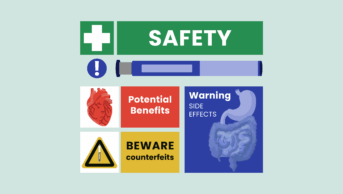
Shutterstock.com
The Medicines and Healthcare products Regulatory Agency (MHRA) has issued a drug safety update, following reports of “serious and life threatening” anticholinergic side effects of hyoscine hydrobromide patches.
The update was issued on 24 July 2023, with the MHRA saying that the side effects were particularly associated with the patches when used outside of their licence.
On 25 July 2023, the MHRA confirmed to The Pharmaceutical Journal that there had been seven yellow card reports of anticholinergic syndrome associated with hyoscine hydrobromide patches in the UK since 2009, including an unexpected death of a child from hyperthermia.
Hyoscine hydrobromide patches are licensed for the prevention of motion or travel sickness, such as nausea, vomiting and vertigo, in adults and children aged over ten years. Outside of their licence, the patches are often recommended in clinical guidance for several other indications.
Commenting on the drug alert, Tarun Nayyar, specialist clinical pharmacist at Birmingham Hospice, said: “In palliative care, we do indeed use these off-label for indications such as reduction of excessive secretions or sialorrhoea, particularly in neurodegenerative conditions, such as motor neurone disease and Parkinson’s.
“From our perspective, the emphasis on the side effects listed [in the drug safety update] is a timely reminder to us as clinicians to be mindful of our approach in prescribing medicines which can add to anticholinergic burden, particularly as many medicines used in specialist palliative care can have anticholinergic pharmacology.
“But I don’t anticipate our practice changing significantly otherwise as hyoscine hydrobromide patches have a defined place in symptom management,” he added.
In the drug safety update, the MHRA advised healthcare professionals to be aware of any serious side effects associated with hyoscine hydrobromide patches, such as high temperature, inability to urinate, confusion, disorientation, seeing or hearing things that are not there, fits or convulsions, reduced consciousness and breathing difficulties. If these symptoms occur, patients are to seek medical advice and remove the patch immediately, the regulator said.
The regulator also highlighted that hyoscine continues to enter the blood stream after patch removal and side effects can persist for up to 24 hours or longer, warning that children and older people are more susceptible to the anticholinergic toxicity.
Graham Stretch, president of the Primary Care Pharmacy Association, welcomed the increased publicity on use of anticholinergic medicines.
“The extra guidance that we’ve received from the MHRA is positive and it might actually encourage us all to think very carefully about [these] problems, particularly [in] elderly patients,” he said.


